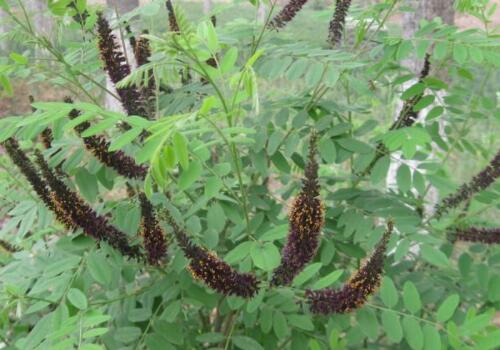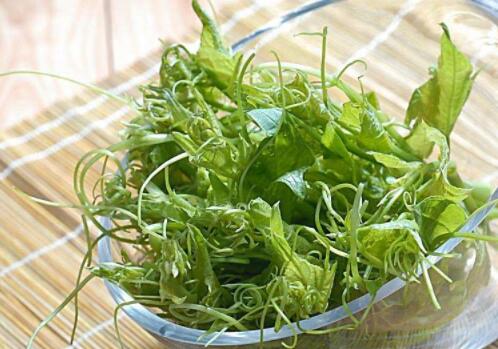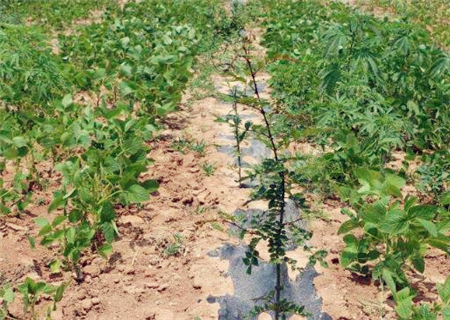Deciduous shrub Amorpha seedlings about how much is a tree? When will it blossom? How many years will it turn out? Planting technology
Amorpha is also called cotton locust, pepper strip, cotton sliver, acacia, purple locust, lath, large leaf quantity and rich in nutrients, containing a lot of crude protein, vitamins, etc., is a nutrient-rich feed plant. So how much does an Amorpha sapling cost? When do they bloom? How long is the flowering period? What are the planting techniques? According to leguminous information, the flower of Amorpha fruticosa blooms in April or May.

How much does an Amorpha seedling cost?
The following is a compilation of prices for reference only.
Seedling Name Height (cm) Price (Yuan) Amorpha 400.12 Amorpha 600.16 Amorpha 800.2
How many years does the tree bear fruit?
Amorpha fruticosa L. is a shrub with light preference, cold tolerance, drought tolerance, moisture tolerance, salt and alkali tolerance, sand resistance and strong resistance. It can grow on barren hills, roadsides, riverbanks and saline-alkali land. It can be propagated by seeds and asexual propagation by root germination. It has strong germination and developed roots. Each clump can reach 20-50 sprouts. After stubble, the annual sprouts can reach 1-2m. After 2 years of flowering, the seed germination rate is 70-80%.
What are the planting techniques of Amorpha tree?
1. The seedling raising method of Amorpha fruticosa seedlings
1. Selection of seedling site: Amorpha fruticosa seedling site should be sandy loam with good drainage;
2. Seed treatment: due to hard seed coat and waxy pericarp, it is difficult to absorb water and germinate slowly. Hot water can be used to soak seeds before sowing;
3, sowing: usually spring sowing, drilling, row spacing 20cm, soil thickness 1 - 1.5 cm, after sowing to suppress, sowing amount per mu 2 - 3kg. Emergence began about 1 week after sowing;
4, seedling management: seedling height 3-5cm when the first thinning seedlings, 6- 8cm when the seedlings, about 20 seedlings per meter. The drought resistance ability increased after seedling height of 25cm, and irrigation was not necessary when it was not seriously dry. 1 year old seedlings up to 80-150cm, can be planted. Seedling taproot is not deep, fibrous root more, seedling easier.
Second, the planting method of Amorpha fruticosa
1. Soil preparation: The suitable sowing time of Amorpha fruticosa is spring and autumn (April to May, September to October). Select sunny, loose texture, good drainage, no gravel, less weeds, more fertile, near neutral loam plot as seedbed. 500~ 750kg decomposed manure, 15~ 20kg calcium superphosphate and calcium magnesium phosphate fertilizer are applied per mu, ploughing is carried out into the soil as base fertilizer, the ploughing depth is about 30cm, the soil is crushed, raked, and the furrow is made, and the width of the furrow is 1~ 2m. Before sowing, the seedbed is opened with shallow grooves according to the row spacing of 20~30 cm, the groove is 3~5 cm deep and 6~8 cm wide, and the treated seeds are sown in the groove. After sowing, the soil is covered with 2 cm thick, and slightly suppressed. Water is sprayed through. The sowing rate is 4~8 kg/mu (weight without soaking).
2, thinning seedlings: generally 5 to 7 days after sowing, 15 days Qi seedlings. When the seedling height is 5~6 cm, carry out the first thinning, eliminate the inferior and save the superior, and achieve uniform distribution; when the seedling height is 10~15 cm, carry out the second thinning, the plant spacing is required to maintain 10 cm, and the seedlings are about 80,000 per mu.
3. Seedling management: After seedling determination, field management should pay special attention to intertillage and weeding and prevent drought. In order to make seedlings grow strong, combined with intertillage weeding, appropriate application of a small amount of nitrogen fertilizer once, such as urea 5 kg per mu can be used.
4. Transplanting: When the plants raised in spring are about 1 meter high, they will be transplanted before winter or spring of the following year; when they are raised in autumn, they will be transplanted before winter of the following year. Cut at 15 cm above the ground before sprouting (strong cuttings can be used as cuttings). When seedlings are raised, attention should be paid to protecting the roots and planting them with them. Dig holes according to the row spacing of 1m × 1.5m, plant 2~3 plants or 3~4 plants in each hole, cultivate soil and tread tightly. If the soil is dry, irrigate it first and then press it tightly. Branches grow in the first year after transplanting, and the branch length can reach about 1.5 meters. After stubble utilization, the branches gradually increase and mature in 3~4 years.
5. Field management: weeding once a year in spring and winter, and applying a small amount of nitrogen fertilizer to achieve stable and high yield. Amorpha has a strong vitality, resistance is very strong, no disease, but occasionally damage the leaves, available chemicals spray kill or kill.
6, harvest: the harvest of the new article should not be harvested, because the annual branches of Amorpha flower rarely fruiting, only more than two years in a row to grow strong and seed more. In order to collect seeds, it is necessary to select and retain mother plants in a planned way, 20~30 branches per pier, no harvest in the first year, and seed collection in autumn of the second year. If managed well, pods yield 100 - 150 kg per mu. Harvested seeds should be dried and stored in time. Amorpha fruticosa over two years can be harvested 2~3 times a year, the first harvest in mid-May, the second harvest in July ~ August, not all harvest, the third harvest in autumn.
Time: 2019-03-19 Click:
- Prev

When do pumpkin seedlings usually be planted? How long will it blossom and bear fruit? Can I eat it? How do you cook it? Attached planting method
Pumpkin, also known as pumpkin, pumpkin, rice melon, pumpkin, pumpkin, annual trailing herbs, introduced into China in the Ming Dynasty, is now widely planted in the north and south. When do the pumpkin seedlings usually be planted? How long will it blossom and bear fruit? Can I eat it? How do you cook it? What are the planting methods? Learned from he Xiangsheng, the grower.
- Next

Is there a subsidy for planting 500 mu of pepper in the country? How much can you earn per mu of land? How to plant high yield? With cost and benefit
Zanthoxylum bungeanum is used as a traditional Chinese medicine, which has the effects of warming qi, expelling cold, relieving pain, killing insects and so on. It is distributed from the south of northeast to the north slope of Wuling in the south and to the coastal areas of Jiangsu and Zhejiang in the southeast. So is there a subsidy for planting 500 mu of pepper in the country? How much can you earn per mu of land? How can planting produce high yield?
Related
- Fuxing push coffee new agricultural production and marketing class: lack of small-scale processing plants
- Jujube rice field leisure farm deep ploughing Yilan for five years to create a space for organic food and play
- Nongyu Farm-A trial of organic papaya for brave women with advanced technology
- Four points for attention in the prevention and control of diseases and insect pests of edible fungi
- How to add nutrient solution to Edible Fungi
- Is there any good way to control edible fungus mites?
- Open Inoculation Technology of Edible Fungi
- Is there any clever way to use fertilizer for edible fungus in winter?
- What agents are used to kill the pathogens of edible fungi in the mushroom shed?
- Rapid drying of Edible Fungi

